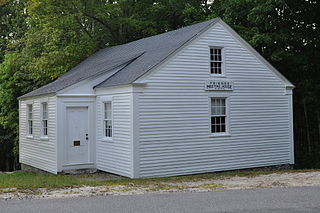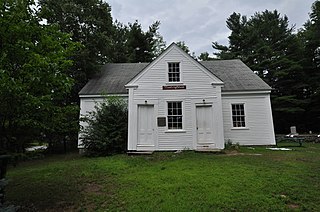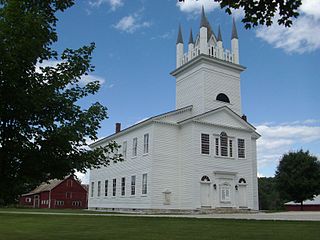
The Benjaminville Friends Meeting House and Burial Ground is a Friends Meeting House of the Religious Society of Friends (Quakers), located north of the rural village of Holder in McLean County, Illinois. It was once the site of a now-defunct village called Benjaminville, founded in 1856 after Quakers settled the area. More Quakers followed, and the burial ground, then the current meeting house in 1874, were constructed. This site, listed on the U.S. National Register of Historic Places since 1983, is all that remains of that village.

The Union Meeting House is a historic church at 2614 Burke Hollow Road in Burke, Vermont. Completed in 1826 as a worship space for four congregations, it is a well-preserved example of vernacular Federal architecture. It was listed on the National Register of Historic Places in 2008.

The South Sutton Meeting House is a historic meeting house at 17 Meeting House Hill Road in South Sutton, New Hampshire. The wood-frame building was constructed in 1839, and is a well-preserved example of rural vernacular Greek Revival architecture. It was listed on the National Register of Historic Places in 1993.

Friends Meetinghouse is a historic Quaker meeting house on Quaker Ridge Road in Casco, Maine. Built in 1814, it is the oldest surviving Quaker meeting house in the state. It was listed on the National Register of Historic Places in 1975.

Pond Meeting House is a historic Quaker meeting house off United States Route 202 in China, Maine. Built in 1807, it is one of the oldest surviving buildings in the town, and an important element in the early life and spiritual growth of Quaker writer Rufus Jones. It was listed on the National Register of Historic Places in 1983.

Shoreham Congregational Church is a historic church on School Street in Shoreham, Vermont. Built in 1846 by a local master builder, it is one of the state's finest examples of ecclesiastical Greek Revival architecture, and also housed local town meetings for more than a century. It was listed on the National Register of Historic Places in 2001.

The Starksboro Village Meeting House is a historic church and town hall on Vermont Route 116 in the village center of Starksboro, Vermont. It was built in 1838 as a cooperative venture between three church congregations and the town, and is a fine local example of Gothic Revival architecture. It was listed on the National Register of Historic Places in 1985.

The Guilford Center Meeting House, formerly the Guilford Center Universalist Church, is a historic building on Guilford Center Road in Guilford, Vermont. Built in 1837, it is a well-preserved example of transitional Greek Revival architecture. The building was added to the National Register of Historic Places in 1982. It is now owned by the local historical society as a community meeting and event space.

The Oak Hill Cemetery Chapel is a historic chapel, located in the Oak Hill Cemetery off Pleasant Street in Bellows Falls, Vermont. Built about 1885, it is one of a small number of 19th-century cemetery chapels in the state, and is the most modestly decorated of those, with vernacular Gothic Revival elements. The building was listed on the National Register of Historic Places in 1991.

Pond Road Chapel is a historic chapel on Pond Road, Town Hwy. #2 in Vernon, Vermont. Built in 1860, it is a well-preserved example of rural, vernacular Greek Revival architecture, with a virtually intact 19th-century interior. The building was listed on the National Register of Historic Places in 1985.

Sudbury Congregational Church, also known as the Sudbury Meetinghouse, is a historic church and town hall at 2702 Vermont Route 30 in Sudbury, Vermont. When it was built in 1807, it was a nearly exact replica of Plate 33 in Asher Benjamin's 1805 Country Builders Assistant. It was listed on the National Register of Historic Places in 1977.

The Nine Partners Meeting House and Cemetery is located at the junction of NY state highway 343 and Church Street, in the village of Millbrook, New York, United States. The meeting house, the third one on the site, was built by a group of Friends ("Quakers") from the Cape Cod region, Nantucket and Rhode Island in 1780.

Beekman Meeting House and Friends' Cemetery is located on Emans Road in LaGrangeville, New York, United States. The meeting house is a wooden building from the early 19th century that has been unused and vacant for decades. As a result, it is in an advanced state of decay, and mostly collapsed. The cemetery, better preserved, is located a short distance away.

The North Sandwich Meeting House is a historic Quaker meeting house at the northwest junction of Quaker-Whiteface Road and Brown Hill Road in Sandwich, New Hampshire. Built in 1881, it is the best-preserved 19th-century Quaker meeting house in the county. The building was listed on the National Register of Historic Places in 1986, at which time it was the only active Quaker meeting house in Carroll County.

The Simeon Smith House is a historic house on Main Road in West Haven, Vermont. Built in 1798–1800 to a design by William Sprat, a prominent housewright from Litchfield, Connecticut, it is a fine example of period Federal architecture. It was built for Simeon Smith, a wealthy businessman who moved here from Connecticut. The house was listed on the National Register of Historic Places in 1983.

Monkton Town Hall is a historic government building on Monkton Ridge Road in Monkton, Vermont. Built in 1859, it is a fine local example of Greek Revival architecture. For many years it was the site of town meetings, and it now houses the town offices. It was listed on the National Register of Historic Places in 1978.

The Hoag Gristmill and Knight House Complex is a former industrial site on State Prison Hollow Road in Starksboro, Vermont. With an industrial history dating to the 1790s, the surviving mill and c. 1820s house are an important reminder of the town's early industrial history. The complex was listed on the National Register of Historic Places in 1980.

143 Highland Avenue is a well-preserved late 19th-century tenement house in the town of Hardwick, Vermont. It was built about 1889 to serve as housing for workers in the area's granite quarries, and preserves a number of the utilitarian features that characterize these types of worker housing. It was listed on the National Register of Historic Places in 2000.

The Lee Tracy House is a historic house on United States Route 7 in the village center of Shelburne, Vermont. Built in 1875, it is one of a small number of brick houses built in the town in the late 19th century, and is architecturally a distinctive vernacular blend of Gothic and Italianate styles. It was listed on the National Register of Historic Places in 1983.
The Meeting House Farm is a historic farm property at 128 Union Village Road in Norwich, Vermont. Encompassing more than 90 acres (36 ha) of woodlands and pasture, the farm has more than 200 years of architectural history, including a late 18th-century farmhouse and an early 19th-century barn. The property was listed on the National Register of Historic Places in 2020.






















